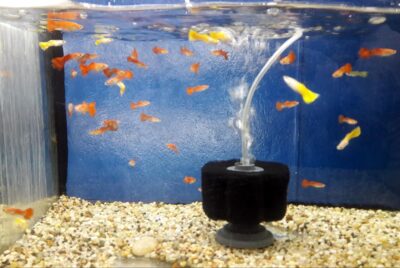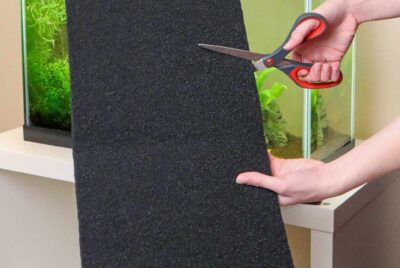How to Clean Aquarium Filter Without Killing Bacteria
The Importance of Aquarium Filter Maintenance
“How to Clean Aquarium Filter Without Killing Bacteria?” As a dedicated fishkeeping enthusiast, I understand the importance of maintaining a healthy and thriving aquarium environment. One crucial aspect of aquarium maintenance is cleaning the filter. In this article, I will guide you on how to clean your aquarium filter effectively without harming the beneficial bacteria that play a vital role in maintaining water quality. By following these simple steps, you can ensure a clean filter while preserving the essential bacterial colonies that keep your aquarium ecosystem balanced and healthy.
Understanding Beneficial Bacteria in Your Aquarium
In the realm of aquarium keeping, beneficial bacteria are a critical component of a healthy and balanced aquatic environment. These microscopic organisms play a pivotal role in maintaining water quality by breaking down harmful substances and preventing the accumulation of toxic compounds.
The Nitrogen Cycle and Beneficial Bacteria
To comprehend the significance of beneficial bacteria, it’s essential to grasp the concept of the nitrogen cycle. In any closed aquatic system, such as an aquarium, fish produce waste in the form of ammonia, a highly toxic compound. Ammonia, if left unprocessed, can cause severe harm to fish, leading to stress, illness, and even death.
This is where beneficial bacteria come into play. They participate in the nitrogen cycle, which is a natural process that converts harmful ammonia into less harmful substances. The nitrogen cycle comprises three main stages:
- Ammonia Conversion: The first stage begins when fish produce waste, releasing ammonia into the water. Beneficial bacteria of the genus Nitrosomonas convert ammonia into nitrites, which are still harmful but less toxic than ammonia.
- Nitrite Conversion: In the second stage, different beneficial bacteria known as Nitrobacter transform nitrites into nitrates. Nitrates are the final product of the nitrogen cycle and are significantly less harmful to fish than ammonia or nitrites.
- Nitrate Reduction: While nitrates are less toxic, they can still negatively impact fish health if present in high concentrations. Regular water changes and the presence of live plants can help reduce nitrates, ensuring a healthier environment for your fish.
Beneficial Bacteria and Filtration
Aquarium filters act as the primary site for the colonization of beneficial bacteria. The filter media, which can include sponge pads, ceramic rings, or bio-balls, provides a large surface area for the bacteria to establish and thrive. As water passes through the filter, it comes into contact with the bacteria, facilitating the conversion of ammonia and nitrites.
Proper filtration is crucial for the well-being of your aquarium. It not only removes physical debris but also supports the growth of beneficial bacteria. Regularly cleaning the filter media, as discussed in the previous section, ensures optimal filtration performance and preserves the bacterial colonies.
Seeding Beneficial Bacteria
When setting up a new aquarium or after a major disruption, such as a thorough filter cleaning, the beneficial bacteria colonies may be compromised or nonexistent. To establish these colonies and jumpstart the nitrogen cycle, a process called “seeding” can be employed.
Seeding involves introducing established filter media or beneficial bacteria supplements from an existing, well-maintained aquarium into the new or disrupted system. This introduces a population of bacteria that can rapidly colonize the filter media and initiate the nitrogen cycle, ensuring a stable and healthy environment for your fish.
Maintaining Beneficial Bacteria
While cleaning the aquarium filter is necessary for optimal performance, it’s important to strike a balance between cleanliness and preserving beneficial bacteria. Excessive cleaning or using harsh chemicals can harm or completely eradicate these essential organisms, leading to ammonia and nitrite spikes that endanger your fish.
When rinsing the filter media, it’s advisable to use aquarium-safe water, such as pre-treated or dechlorinated water, to avoid chlorine or chloramine exposure. Additionally, gentle swishing and rinsing are usually sufficient to remove debris without disrupting the bacterial colonies.
Regularly monitoring water parameters, such as ammonia, nitrite, and nitrate levels, is crucial for assessing the health of the beneficial bacteria. Ammonia and nitrite should ideally be undetectable, while nitrates should be kept at manageable levels through regular water changes and plant care.
The Importance of Beneficial Bacteria for Fish Health
The presence of a thriving population of beneficial bacteria in your aquarium has numerous benefits for the overall health and well-being of your fish:
- Water Quality Regulation: Beneficial bacteria actively break down toxic compounds, such as ammonia and nitrites, preventing their accumulation and maintaining a stable and safe aquatic environment for your fish.
- Reduced Stress and Illness: Clean and well-maintained water, facilitated by beneficial bacteria, helps reduce stress on fish, making them less susceptible to diseases and health issues.
- Enhanced Immune System: By providing a clean and balanced environment, beneficial bacteria support the immune system of your fish, enabling them to resist diseases and infections more effectively.
- Improved Growth and Coloration: Fish in a healthy and well-maintained aquarium often exhibit enhanced growth rates and vibrant coloration, indicating their overall vitality.
Signs That Your Aquarium Filter Needs Cleaning
Regularly monitoring your aquarium’s filter is crucial for its optimal performance. Here are some signs that indicate it’s time to clean your filter:
- Reduced water flow: If you notice a decrease in water flow from your filter, it may indicate a clogged filter media.
- Accumulation of debris: Visible debris or grime on the filter media is a clear sign that it needs cleaning.
- Foul odor: A strong, unpleasant odor coming from the filter suggests a build-up of organic waste that needs to be removed.
Gather the Necessary Supplies
Before you begin the cleaning process, gather the following supplies:
- A clean bucket or container
- Aquarium-safe water (pre-treated or dechlorinated)
- New filter media (if necessary)
- Soft-bristle brush or toothbrush
- Aquarium-safe cleaning solution (if needed)
- Towels or paper towels
With these supplies ready, let’s move on to the step-by-step process of cleaning your aquarium filter without harming the beneficial bacteria.
Step 1: Turn Off and Unplug the Filter – (How to Clean Aquarium Filter Without Killing Bacteria)
For safety reasons, always turn off and unplug the filter before beginning the cleaning process. This prevents any electrical accidents and ensures your filter can be cleaned without disruption.
Step 2: Remove the Filter Media – (How to Clean Aquarium Filter Without Killing Bacteria)
Carefully remove the filter media from the filter housing. Depending on your filter type, this could be sponge pads, ceramic rings, activated carbon, or any other filter media. Be gentle while handling the media to avoid damaging it.
Step 3: Rinse the Filter Media – (How to Clean Aquarium Filter Without Killing Bacteria)
Using aquarium-safe water, gently rinse the filter media to remove excess debris and dirt. Avoid using tap water, as the chlorine or chloramines in it can harm the beneficial bacteria. A gentle swishing motion in the bucket of water is sufficient to clean the media thoroughly.
Step 4: Clean the Filter Housing – (How to Clean Aquarium Filter Without Killing Bacteria)
While the filter media is rinsing, take the opportunity to clean the filter housing. Use a soft-bristle brush or toothbrush to remove any accumulated dirt or grime. If necessary, you can use an aquarium-safe cleaning solution for stubborn stains. Rinse the housing thoroughly with aquarium-safe water before moving on to the next step.
Step 5: Reassemble the Filter – (How to Clean Aquarium Filter Without Killing Bacteria)
Once the filter media and housing are clean and dry, reassemble the filter. Ensure each component is correctly positioned and securely in place. Refer to the manufacturer’s instructions if needed.
Step 6: Prime and Restart the Filter – (How to Clean Aquarium Filter Without Killing Bacteria)
Before turning the filter back on, prime it according to the manufacturer’s instructions. This process ensures the filter is adequately filled with water, preventing airlocks and enabling proper functioning. Once primed, plug in the filter and turn it on. Monitor the water flow and check for any leaks.
Regular Maintenance Tips to Preserve Beneficial Bacteria
To maintain a healthy balance of beneficial bacteria and minimize the need for frequent filter cleanings, consider the following tips:
- Avoid overfeeding your fish, as excess food can lead to increased waste and a higher demand on the filter.
- Perform regular water changes to remove accumulated nitrates and other pollutants.
- Avoid excessive cleaning of the filter media. Gentle rinsing is usually sufficient, unless there is a significant build-up of debris.
- Monitor water parameters regularly to ensure proper water quality.
Conclusion
Properly cleaning your aquarium filter is essential for maintaining a healthy and thriving aquarium ecosystem. By following the steps outlined in this article, you can clean your filter without harming the beneficial bacteria that are vital for your fish’s well-being. Remember to regularly monitor your filter’s condition and perform maintenance as needed to ensure optimal performance and a clean environment for your aquatic companions.
Frequently Asked Questions – (How to Clean Aquarium Filter Without Killing Bacteria)
Q: Can I use tap water to clean my filter media?
A: It is best to avoid tap water, as the chlorine or chloramines in it can harm the beneficial bacteria. Use aquarium-safe water that is pre-treated or dechlorinated.
Q: How often should I clean my aquarium filter?
A: The frequency of cleaning depends on various factors, including the fish load, filter type, and water parameters. As a general guideline, aim for monthly filter cleanings, but adjust based on your specific aquarium’s needs.
Q: Should I replace the filter media during cleaning?
A: If the filter media is severely deteriorated or damaged, it’s advisable to replace it. However, in most cases, gentle rinsing is sufficient to remove debris, and frequent media replacement is unnecessary.
Q: Can I clean the entire filter assembly at once?
A: It is recommended to clean different components separately to prevent disrupting the beneficial bacterial colonies. Clean the filter media and housing individually as outlined in the article.
Q: How long does it take for beneficial bacteria to establish after cleaning the filter?
A: Beneficial bacteria colonies can recover and establish within a few days after cleaning the filter. Regular monitoring of water parameters can help ensure their reestablishment.




